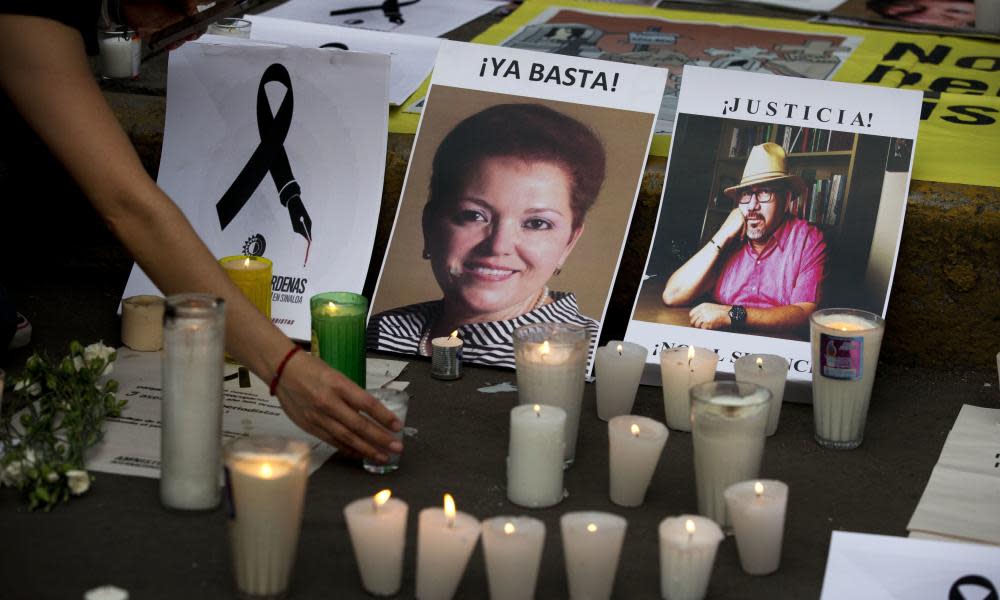Mexico world's deadliest country for journalists, new report finds

Mexico was the deadliest country in the world for the media in 2020, accounting for almost a third of journalists killed this year, according to the Committee to Protect Journalists, which investigates attacks against the press globally.
Nine journalists were killed in Mexico in 2020, bringing the death toll to at least 120 since 2000. Last month, three journalists were shot dead within 10 days.
Related: ‘They’re culpable’: the countries supplying the guns that kill Mexico’s journalists
This year’s death count means that Mexican journalists are now more likely to be killed than those covering wars – the first time the country has held this inglorious top ranking since CPJ began tracking violence against the media in 1992.
“Mexico is suffering a multi-faceted crisis with regard to press freedom. The situation has been getting steadily worse over the past few years, culminating in the country’s abysmal status as the world’s deadliest for reporters in 2020. The crisis principally stems from impunity,” said Jan-Albert Hootsen, CPJ’s Mexico representative. Overall, at least 90% of journalist killings remain unsolved.
Mexico has long been the most dangerous place for journalists outside an official war zone, with those investigating the nexus between organised crime and corrupt officials most frequently targeted.
Press freedom campaigners hoped that the dire situation would improve after the election of president Andrés Manuel López Obrador in 2018, who pledged to tackle violence against journalists and end the impunity for the perpetrators.
But attacks have spiraled amid unprecedented public hostility towards the media by the president who has frequently used daily press briefings to denigrate independent journalists and activists.
The government has also weakened protection for journalists under threat and cut funds for investigations. Two of the journalists killed this years were under supposed federal protection after having reported deaths threats linked to their work. In both cases their assigned bodyguards also died in the attacks.
Earlier this month, 25 international news media organisations, including the Guardian, published a series into the killing of journalists investigating links between organised crime and state officials in Mexico.
The Cartel Project, coordinated by Forbidden Stories – a global network of investigative journalists whose mission is to continue the work of reporters who are threatened, censored or killed – revealed details about how journalists have even been monitored by espionage units ostensibly set up to prevent organised crime.
Related: Murder in Mexico: journalists caught in the crosshairs
“Criminal groups often collude with local authorities which leads to journalists being not only targeted, but also not finding any help from the authorities that are supposed to protect them. The federal government had done very little to stop the violence. The result is impunity in the vast majority of crimes against the press, which fuels and incentivizes more attacks against journalists,” said Hootsen.
Tuesday’s report makes clear that press freedom is under attack by criminal gangs and elected officials across the world.
Globally, at least 30 journalists were killed between January and mid-December 2020, according to the CPJ. Of those, 21 were targeted in retaliation for their work - more than double the number of retaliatory killings documented in 2019. The true number of journalists targeted because of their work could be significantly higher as the CPJ continues to investigate the motive behind 15 other killings.
After Mexico, Afghanistan and the Philippines had the most retaliatory killings.
Three journalists were killed in Honduras, where senior members of the rightwing government – considered a key US ally – have alleged links to international drug trafficking networks, according to US prosecutors. A fourth, radio journalist Pedro Canelas who was shot dead at the weekend, is not included in the CPJ figures.
While murders rose overall in 2020, the number of direct combat-related deaths –three – fell to the lowest level since 2000, as the Covid pandemic dominated media attention and made travel difficult for journalists. All three journalists were documenting the conflict in northern Syria, and died during airstrikes by suspected Russian forces allied with Bashar al-Assad.
Despite the drop in crossfire-related killings, countries in conflict remain dangerous for the media. On Monday, another Afghan journalist was gunned down in the eastern city of Ghazni – the fifth to be killed this year.

